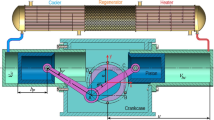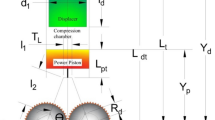Abstract
This study involves performance examination of an alpha-type novel Stirling engine and performance comparison with a V-type alpha engine. The novel engine displays very different features from the conventional V-type alpha engine. In the conventional engine, the work calculated with nodal analysis (real work) is lesser than isothermal work. In the novel engine, however, the real work becomes larger than the isothermal work if the heat transfer in compression and expansion cylinders is poor. If performances of engines are compared for equal amount of working fluid mass, the real work of the novel engine is always larger than the real work of the conventional V-type alpha engine. If performance comparison is made for equal amount of charging pressure of the working fluid, the difference of works of engines becomes multiple. The thermal efficiency of the novel engine is also greater. At relatively lower speeds and lower charging pressures of the engine, the efficiency difference between novel engine and conventional engine becomes more than 25%. The mean gas pressure in the novel engine is about 40% lesser than that in the conventional engine. All of the properties of the novel engine were found to be advantageous except flow losses.

















Similar content being viewed by others
Abbreviations
- A c :
-
Crosscut area of regenerator shell (m2)
- A k :
-
Heat transfer area of cells (m2)
- A p :
-
Area of piston crowns (m2)
- C p :
-
Constant pressure specific heat of working fluid (J/kg K)
- C v :
-
Constant volume specific heat of working fluid (J/kg K)
- \(D_{k}^{h}\) :
-
Hydraulic diameter (m)
- e :
-
Distance from cylinder axis to crankshaft center (m)
- f :
-
Regenerator friction factor
- \(H^{i}\) :
-
Enthalpy follow into cells (J)
- \(H^{o}\) :
-
Enthalpy follow out of the cells (J)
- h p :
-
Distance from piston pin center to piston top (m)
- \(H_{{\mathrm{p}}}\) :
-
Length of piston (m)
- \(\ell\) :
-
Thickness of regenerator cells (m)
- m :
-
Total gas mass (kg)
- \(\dot{m}\) :
-
Time derivative of mass in cells
- N p :
-
Number of pistons
- Nu:
-
Nusselt number
- p :
-
Pressure exerting on the piston top (Pa)
- \(Q_{{\mathrm{c}}}\) :
-
Heat from gas to cooler (J)
- \(Q_{{\mathrm{h}}}\) :
-
Heat from heater to gas (J)
- R :
-
Crank radius of novel engine (m)
- Re:
-
Reynolds number
- \(\Re\) :
-
Gas constant of working fluid (J/kg K)
- S :
-
Crank radius of the V-type engine (m)
- \(T_{{\mathrm{c}}}\) :
-
Cold end inner surface temperature (K)
- \(T_{{\mathrm{h}}}\) :
-
Hot end inner surface temperature (K)
- \(T_{k}\) :
-
Working gas temperature in the cells (K)
- Δt :
-
Differential of time
- ΔT k :
-
The temperature variation in cells during a time step (K)
- u :
-
Distance from crankshaft axis to cylinder top for novel engine (m)
- \(V_{{\mathrm{cc}}}\) :
-
Cold cylinder volume (m3)
- \(V_{{\mathrm{hc}}}\) :
-
Hot cylinder volume (m3)
- \(V_{k}\) :
-
Volume of cells (m3)
- \(W\) :
-
Work obtained with nodal analysis (J/cyc)
- \(W_{{{\text{iso}}}}\) :
-
Work obtained with isothermal analysis (J/cyc)
- x :
- \(x_{l}\) :
-
The position of compression piston (m)
- \(x_{r}\) :
-
The position of expansion piston (m)
- y :
- Z :
-
Distance from crankshaft axis to cylinder top for V-type engine (m)
- \(\varepsilon\) :
-
Minimum distance between cylinder top and piston top (m)
- \(\lambda\) :
-
Length of piston connecting rod of novel engine (m)
- η :
-
Thermal efficiency
- \(\mu {\kern 1pt}\) :
-
Kinematic viscosity (m2/s)
- θ :
-
Amount of crankshaft rotation (rad) or (°)
- \(\rho\) :
-
Density (kg/m3)
- τ :
-
Length of piston connecting rod for the V-type engine (m)
- \(\phi\) :
-
Porosity
- \(\psi\) :
-
Angle between cylinder axis and connecting rod for novel engine, Fig. 1
- \(\psi_{{\mathrm{c}}}\) :
-
Angle between cylinder axis and connecting rod of cold piston for V-type alpha engine, Fig. 2
- \(\psi_{{\mathrm{h}}}\) :
-
Angle between cylinder axis and connecting rod of hot piston for V-type alpha engine, Fig. 2
- Ω :
-
A dummy constant used in energy equation to avoid divergence of solution process
- c:
-
Cold
- h:
-
Hot
- k :
-
Cell counter
- p:
-
Piston
References
Abuelyamen A, Ben-Mansour R, Abualhamayel H, Mokheimer EMA (2017) Parametric study on beta-type Stirling engine. Energy Convers Manag 145:53–63
Ahmed F, Hulin H, Khan AM (2019) Numerical modeling and optimization of beta-type Stirling engine. Appl Therm Eng 149:385–400
Aksoy F, Cinar C (2013) Thermodynamic analysis of a beta-type Stirling engine with rhombic drive mechanism. Energy Convers Manag 75:319–324
Aksoy F, Karabulut H (2013) Performance testing of a fresnel/Stirling micro solar energy conversion system. Energy Convers Manag 75:629–634
Alfarawi S (2020) Thermodynamic analysis of rhombic-driven and crank-driven beta-type Stirling engines. Int J Energy Res 44:5596–5608
Almajri AK, Mahmoud S, Al-Dadah R (2017) Modelling and parametric study of an efficient alpha type Stirling engine performance based on 3D CFD analysis. Energy Convers Manag 145:93–106
Babaelahi M, Sayyaadi H (2014) Simple-II: a new numerical thermal model for predicting thermal performance of Stirling engines. Energy 69:873–890
Bataineh K (2018) Mathematical formulation of alpha-type Stirling engine with Ross Yoke mechanism. Energy 164:1178–1199
Chatterton S, Pennacchi P (2015) Design of a novel multicylinder Stirling engine. J Mech Des 137:1–12
Chen WL, Chen CK, Fang MJ, Yang YC (2018) A numerical Study on applying slot-grooved displacer cylinder to a-type medium-temperature-differential Stirling engine. Energy 144:679–693
Cheng CH, Yang HS, Keong L (2013) Theoretical and experimental study of a 300-W beta-type Stirling engine. Energy 59:590–599
Cinar C, Aksoy F, Erol D (2011) The effect of displacer material on the performance of a low temperature differential Stirling engine. Int J Energy Res 36:911–917
Gheith R, Hachem H, Aloui F, Ben Nasrallah S (2015) Experimental and theoretical investigation of Stirling engine heater: parametrical optimization. Energy Convers Manag 105:285–293
Hachem H, Gheith R, Aloui F, Ben Nasrallah S (2015) Numerical characterization of a gamma-Stirling engine considering losses and interaction between functioning parameters. Energy Convers Manag 96:532–543
Hu JY, Luo EC, Zhang LM, Chen YY, Wu ZH, Gao B (2018) Analysis of a displacer-coupled multi-stage thermoacoustic-Stirling engine. Energy 145:507–514
Karabulut H, Aksoy F, Öztürk E (2009) Thermodynamic analysis of a β type Stirling engine with a displacer driving mechanism by means of a lever. Renew Energy 34:202–208
Karabulut H, Yücesu HS, Koca A (2000) Manufacturing and testing of a V-type Stirling engine. Turk J Eng Environ Sci 24:71–80
Karabulut H, Cinar C, Öztürk E, Yücesu HS (2010) Torque and power characteristics of a helium charged Stirling engine with a lever controlled displacer driving mechanism. Renew Energy 35:138–143
Karabulut H, Okur M, Halis S, Altin M (2019a) Thermodynamic, dynamic and flow friction analysis of a Stirling engine with Scotch yoke piston driving mechanism. Energy 168:169–181
Karabulut H, Okur M, Ozdemir AO (2019b) Performance prediction of a Martini type of Stirling engine. Energy Convers Manag 179:1–12
Kongtragool B, Wongwises S (2005) Investigation on power output of the gamma-configuration low temperature differential Stirling engines. Renew Energy 30:465–476
Kuban L, Stempka J, Tyliszczak A (2019) A 3D-CFD study of a γ-type Stirling engine. Energy 169:142–159
Li R, Grosu L, Li W (2017) New polytropic model to predict the performance of beta and gamma type Stirling engine. Energy 128:62–76
Mabrouk MT, Kheiri A, Feidt M (2014) Displacer gap losses in beta and gamma Stirling engines. Energy 72:135–144
Martaj N, Grosu L, Rochelle P (2007) Thermodynamic study of a low temperature difference Stirling engine at steady state operation. Int J Thermodyn 10:165–176
Mou J, Hong G (2017) Startup mechanism and power distribution of free piston Stirling engine. Energy 123:655–663
Ni M, Shi B, Xiao G, Peng H, Sultan U, Wang S, Luo Z, Cen K (2016) Improved simple analytical model and experimental study of a 100 W β-type Stirling engine. Appl Energy 169:768–787
Sheykhi M, Chahartaghi M, Hashemian SM (2020) Performance evaluation of a combined heat and power system with Stirling engine for residential applications. Iran J Sci Technol Trans Mech Eng 44:975–984
Tanaka M, Yamashita I, Chisaka F (1990) Flow and heat transfer characteristics of the Stirling engine regenerator in an oscillating flow. JSME Int J 33:283–289
Tavakolpour-Saleh AR, Zare SH, Bahreman H (2017) A novel active free piston Stirling engine: modeling, development, and experiment. Appl Energy 199:400–415
Tlili I, Timoumi Y, Nasrallah SB (2008) Analysis and design consideration of mean temperature differential Stirling engine for solar application. Renew Energy 33:1911–1921
Urieli I, Berchowitz DM (1984) Stirling cycle engine analysis. Adam Hilger Ltd., Bristol
Walker G (1980) Stirling engines. Clarendon Press, Oxford
Wang K, Sanders SR, Dubey S, Choo FH, Duan F (2016) Stirling cycle engines for recovering low and moderate temperature heat: a review. Renew Sustain Energy Rev 62:89–108
White EW (15 Nov 1983) Inventor: White Eugene W, assignee. Solar heat engines. United States patent US 4,414,814
Zare S, Tavakolpour-Saleh AR, Aghajanzadeh O (2017) An investigation on the effects of gas pressure drop in heat exchangers on dynamics of a free piston Stirling engine. Int J Eng Trans B 30:150–160
Author information
Authors and Affiliations
Corresponding author
Rights and permissions
About this article
Cite this article
Karabulut, H., Okur, M. & Cinar, C. Mechanical Configuration and Thermodynamic Analysis of an Alpha-Type Stirling Engine with Crank-Shifted Driving Mechanism. Iran J Sci Technol Trans Mech Eng 46, 431–448 (2022). https://doi.org/10.1007/s40997-021-00436-2
Received:
Accepted:
Published:
Issue Date:
DOI: https://doi.org/10.1007/s40997-021-00436-2




